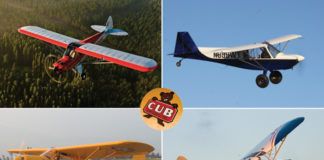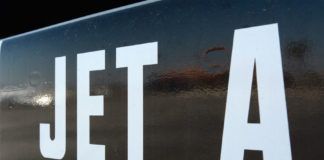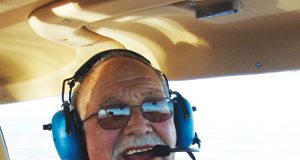If you want to know how important something is to you, do without it for a while. When my F-1 EVO Rocket was in maintenance for two months, I realized the role my magic carpet plays in my life. Full disclosure compels me to confess that I nearly always have other airplanes to fly. It’s not like I am relegated to driving, but two months of flying the alternatives gives me renewed appreciation for the Rocket.
My affliction with homemade airplanes began in the early 1990s. Flying the CAF B-25 Miss Mitchell meant regular trips to St. Paul. I wanted something small and fast to get me there—who wouldn’t? My first purchase was a modified Cassutt derivative with a hybrid Lycoming O-290 fitted with helicopter cylinders and a horribly high stall speed. It was like a cruise missile with a seat. It demanded constant attention and a steady hand.
An engine failure was my worst fear, and that’s exactly what happened while clipping a ribbon for a runway grand opening. Whether the carburetor swallowed the ribbon, or the fuel tank unported, doesn’t matter. The result was the same: a dead-stick landing in a soybean field at 100 mph. I survived—with a shattered kneecap—but the airplane did not. It’s probably just as well. It was not a good airplane for cross-country cruising, but it remains the most exciting airplane I have ever flown.
Ouch, That Hurts!
The reason mobsters break kneecaps is simple. It is an experience that will never be forgotten, and the behavior that precipitated the event will not be repeated. After my recovery, I had no further interest in small airplanes with high stall speeds. Reasonable off-airport landing speed is now more important to me than cruise speed in single-screw airplanes.
Acceptable landing speed, high cruise speed and affordable acquisition price were the parameters that led me to buy an RV-4. My first was a VFR machine with a wood prop and a 160-horsepower engine that was for sale at a bargain price because it was pink. Not all pink, but it was trimmed in pink, and the cosmetic sales lady jokes were endless. “Is your Cadillac pink, too?” or “Do you have any lipstick in that shade?” My wife jokingly suggested a pink flamingo on the tail. Yeah, right. No pink flamingos for me, but a panther would do. With some vinyl graphics, the Pink Panther was born, and the joke was on the jokers.
RV-4s fly wonderfully, and I loved mine. The problem was the airplane was so fast and my truck was so slow that I found myself flying in weather when I should have been driving. I made a personal commitment to stop scud running, and I upgraded to another RV-4 with IFR instrumentation and a constant-speed propeller. Ten years of RV flying, and it seemed the RV-4 was the perfect airplane—but there was a problem.
Flying IFR in a tandem-seat airplane with a tiny panel and limited storage is an acquired skill. F-16 pilots cross the oceans with less cockpit storage than the RV-4, and if they could do it, so could I. Planning is the key.
Speed Is a Drug
That speed is enticing is not a secret, and after eight years the speed drug of the RV-4 was wearing off. From my base in Iowa nearly all points east of the Rocky Mountains were within one-stop distance. Day, night, IFR and even IFR at night—it all worked out. The RV-4 had cruise performance like a Bonanza or Cessna 210, and that was how I flew it, but I wanted to go faster.
Everything in aviation is a compromise, and the first question in the upgrade process was what airplane would suit my needs? I loved the fighter-like feel of the RV-4 and had learned how to live and work in a small cockpit. The room of a side-by-side cockpit is nice, but sitting on the centerline with a right-hand stick is nicer. Call that a wash, leaning toward tandem seating.
What is not a compromise is money. There was a finite supply, and the budget was south of $200K. Gentleman’s aerobatics was another non-negotiable, so the fast four-seaters like the Lancair IV were eliminated early.
Composite construction allows airplanes to be designed based on how they pass through the air rather than the building process. Further, the quality of the fibers and the resins has improved greatly, but in the back of my mind was a concern about buying a plastic airplane that had been built by someone I did not know. Several composite airplanes are assembled with builder’s assistance from reputable shops or factories, and if it would be composite for me, it would have to be a builder-assist airplane. In my mind, that dramatically reduced the Lancair 360 or Glasair possibilities.
Speed was the driving factor, but cruise speed is a compromise, too. As cruise speed goes up, either stall speed goes up with it, or the airplane becomes fragile. The maneuvering speed of an airplane is the stall speed at the positive structural limit. A high-stall-speed airplane that could result in another broken kneecap, or worse, was not an option.
Living in Iowa, there is a choice: Either put the airplane away in October and come back in May, or face the fact that no matter how careful you are, sooner or later you will get caught in some ice. That fact further argued against designs with high stall speeds and wing loadings. They would not be any fun at all in the ice, and they got cut.
Compromises, Now a Conclusion
The list of considerations and compromises goes on and on. When it all shook out, I decided that a Rocket was right for me—and my timing paid off. Mark Frederick of Team Rocket was ready to sell Ole 84. It was the factory demonstrator with an EVO wing. I bought it, installed a Garmin GNS 430 and a Dynon EFIS-D100. I’ll tell you how I like it in a minute, but first a bit more about the airplane.
My RV cruised at between 155 and 170 KTAS. The Rocket varies between 195 and 210 KTAS, depending on altitude and fuel flow. For practical cruising, both airplanes are fastest at around 8000 feet and get more efficient with altitude. Forty knots is a big deal. Everything east of the Rockies except Florida was one stop in the RV-4. Now all of Florida and as far west as Phoenix are fair game for one-stop trips. Airline travel is like a bad dream that I keep trying to forget.
The West Coast is beyond the range of one stop, but if travel plans involve multiple destinations, a California trip is not a stretch at all in the Rocket. Last summer there was a story at Hawker-Beechcraft in Wichita and another in Los Angeles. Wichita to Double Eagle in New Mexico, and then to John Wayne Airport in Orange County (KSNA) was the plan. Flying over Guymon, Oklahoma, I checked in with Greg Downing of Centerline Aviation. Greg said the burgers were going on the grill and invited me to drop down for lunch. After a quick meal with friends, I continued to St. John, Arizona, and on to SNA.
Over Palm Springs at 17,000 feet, L.A. Center called traffic descending above me. A Piaggio Avanti was also headed for SNA. I followed him all the way to the ILS and was told twice to reduce speed for spacing. The pilot of the Italian hot rod was unloading bags when I parked next to him on the ramp. He stopped his work and walked over to marvel at a homebuilt, piston-powered airplane that was chasing the world’s fastest business turboprop.
My work was finished the next day at 5 p.m., so rather than spend another night in Southern California, I started home. Ten minutes after takeoff I was leveling at 17,000 feet headed for Falcon Field at Mesa, Arizona. Two hours later, a frosty beverage was waiting at the Falcon Field Airport saloon, The Roost. The following morning, I launched toward Guymon again for a quick fuel stop then direct to MCW. Eastbound legs at 15 or 17,000 feet often get a westerly wind push that yields groundspeeds in the 240-knot range. By mid-afternoon the Rocket was tucked in its hangar, and I was back in my office, catching up at work.
It’s Not Totally About Speed
It might be enough to have a magic carpet that shrinks the globe, but there is more. Sitting beneath a bubble canopy on the centerline in an airplane with a stick in your right hand and a throttle in your left evokes the feeling of a fighter. The big Lycoming blocking forward view out front and the tailwheel in back adds a WW-II element to the experience. Taking the runway in a P-51 Mustang or F-4U Corsair is a thrill, but that exhilaration is tempered with the realization that the airplane is an historic artifact powered by a 60-year-old engine. Whether you own it or just fly it, the responsibility of returning it with all its parts and pieces attached and the consequences of an engine failure never really leave your mind. The naturally aspirated, parallel-valve Lycoming has a reputation for dependability, yet having a plan for an engine failure, and having an airplane with a survivable off-airport landing speed, reduce the apprehension and increase the fun of flying.
Whether in a WW-II fighter or in the Rocket, the initial acceleration on takeoff is impressive. The Rocket’s tail comes up quickly, and the tires leave the ground moments later. If a low transition in ground effect is the objective, then nearly continuous application of nose-down trim is required to keep the airplane from climbing. At the end of a 5000-foot runway, the Rocket will be indicating more than 160 knots. A smooth, steady pull to a ridiculously steep chandelle-like turn will yield a breathtaking elevator ride to a midfield downwind 2500 feet above the ground. Still climbing 3000 fpm and indicating 120 knots is a great ride, and it never seems to get old.
Another thing that never gets old is blasting up through the overcast into the bright sunshine on a dreary day. A few minutes in the sun can have a profound impact on the miserable attitude that comes from a week of rain or snow.
Whether the excursion into the sunshine is a part of a long cross-country trip, or just an IFR clearance to VFR-on-top for some aerobatic sunbathing, the experience is even better when ATC obliges a level off in the cloud tops. The Rocket accelerates quickly, and a few moments at climb power will put 180 knots on the airspeed indicator. If the cloud tops are at 8000 feet, that’s 210 knots true airspeed, or 240 mph. The clouds pass by the canopy quickly, and the need for speed is satiated along with the need for sunshine.
Unfortunately, every flight must end. IFR endings in the Rocket can be both challenging and rewarding. When the need arises and reasonable ceilings allow, the Rocket can interface with traffic ranging from single-engine pistons to the fastest jets. Flying ILS approaches at 140 knots is good practice, and good fun. On a lazy day, or when the ceilings are low, let the TruTrak autopilot couple up to the Garmin 430 WAAS and watch it work. The autopilot tracks the course line perfectly. In procedure turns, holding patterns or the final approach course, the only pilot intervention required is to dial in a descent rate and adjust it to track the glideslope. The next upgrade is to add the last “V” to my Digiflight VSG to couple with my recently upgraded 430W. The VSGV adds vertical guidance inputs to the two-axis Digiflight, so it will capture and track the WAAS glideslope. It’s too easy. Should probably be illegal.
Traveling With It
In the last 18 months the Rocket tach has rolled up 300 hours, which included trips to the Atlantic, Pacific and Gulf coasts, and the Canadian border. The longest leg so far has been from Midland, Texas, to Mason City, Iowa. That’s 793 n.m. in 4 hours and 10 minutes at 17,000 feet on 43.5 gallons of 100LL with only a 10-knot average tailwind. The fastest level flight groundspeed was 268 knots on a Florida trip.
A newspaper reporter once interviewed me for a story about regional economic development. I was rambling on about the opportunities I saw in our area and how the confluence of many resources made our location ideally suited for growth. The reporter stopped me and asked, “Does flying change your perspective of our community and the world?” I’ve thought about it, and I’ve concluded that it does. Flying allows me to see my community and the world from a different angle. Flying a Rocket makes my community much bigger and the world much smaller.




